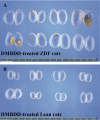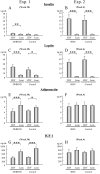Enhanced Urinary Bladder, Liver and Colon Carcinogenesis in Zucker Diabetic Fatty Rats in a Multiorgan Carcinogenesis Bioassay: Evidence for Mechanisms Involving Activation of PI3K Signaling and Impairment of p53 on Urinary Bladder Carcinogenesis
- PMID: 22272041
- PMCID: PMC3234622
- DOI: 10.1293/tox.24.25
Enhanced Urinary Bladder, Liver and Colon Carcinogenesis in Zucker Diabetic Fatty Rats in a Multiorgan Carcinogenesis Bioassay: Evidence for Mechanisms Involving Activation of PI3K Signaling and Impairment of p53 on Urinary Bladder Carcinogenesis
Abstract
In the present study, modifying effects of diabetes on carcinogenesis induced in type 2 diabetes mellitus model Zucker diabetic fatty (ZDF) rats were investigated using a multiorgan carcinogenesis bioassay. Our re sults demonstrated enhancement of urinary bladder, colon and liver carcinogenesis in ZDF rats treated with five types of carcinogens (DMBDD). Elevated insulin and leptin and decreased adiponectin levels in the serum may be responsible for the high susceptibility of type 2 diabetes mellitus model rats to carcinogenesis in these organs. Possible mechanisms of increased susceptibility of diabetic rats to bladder carcinogenesis could be activation of the PI3K pathway and suppression of p53 in the urothelium in consequence of the above serum protein alterations.
Keywords: PI3K; bladder carcinogenesis; p53; type 2 diabetes mellitus.
Figures






Similar articles
-
Enhanced Susceptibility of Ogg1 Mutant Mice to Multiorgan Carcinogenesis.Int J Mol Sci. 2017 Aug 18;18(8):1801. doi: 10.3390/ijms18081801. Int J Mol Sci. 2017. PMID: 28820464 Free PMC article.
-
Alternative Multiorgan Initiation-Promotion Assay for Chemical Carcinogenesis in the Wistar Rat.Toxicol Pathol. 2016 Dec;44(8):1146-1159. doi: 10.1177/0192623316678931. Toxicol Pathol. 2016. PMID: 28245158
-
Cocoa-rich diet ameliorates hepatic insulin resistance by modulating insulin signaling and glucose homeostasis in Zucker diabetic fatty rats.J Nutr Biochem. 2015 Jul;26(7):704-12. doi: 10.1016/j.jnutbio.2015.01.009. Epub 2015 Mar 13. J Nutr Biochem. 2015. PMID: 25814291
-
Differences in plasma homocysteine levels between Zucker fatty and Zucker diabetic fatty rats following 3 weeks oral administration of organic vanadium compounds.J Trace Elem Med Biol. 2006;19(4):251-8. doi: 10.1016/j.jtemb.2005.10.001. Epub 2005 Dec 13. J Trace Elem Med Biol. 2006. PMID: 16443173
-
Improved metabolic status and insulin sensitivity in obese fatty (fa/fa) Zucker rats and Zucker Diabetic Fatty (ZDF) rats treated with the thiazolidinedione, MCC-555.Br J Pharmacol. 1998 Dec;125(8):1708-14. doi: 10.1038/sj.bjp.0702245. Br J Pharmacol. 1998. PMID: 9886762 Free PMC article.
Cited by
-
Detection of γ-H2AX, a Biomarker for DNA Double-strand Breaks, in Urinary Bladders of N -Butyl- N -(4-Hydroxybutyl)-Nitrosamine-Treated Rats.J Toxicol Pathol. 2013 Jun;26(2):215-21. doi: 10.1293/tox.26.215. Epub 2013 Jul 10. J Toxicol Pathol. 2013. PMID: 23914065 Free PMC article.
-
Obesity, independent of p53 gene dosage, promotes mammary tumor progression and upregulates the p53 regulator microRNA-504.PLoS One. 2013 Jun 28;8(6):e68089. doi: 10.1371/journal.pone.0068089. Print 2013. PLoS One. 2013. PMID: 23840816 Free PMC article.
-
The role of adipocytokines and their receptors in bladder cancer: expression of adiponectin or leptin is an independent prognosticator.Am J Transl Res. 2020 Jun 15;12(6):3033-3045. eCollection 2020. Am J Transl Res. 2020. PMID: 32655828 Free PMC article.
-
Enhanced Susceptibility of Ogg1 Mutant Mice to Multiorgan Carcinogenesis.Int J Mol Sci. 2017 Aug 18;18(8):1801. doi: 10.3390/ijms18081801. Int J Mol Sci. 2017. PMID: 28820464 Free PMC article.
-
Diphenylarsinic acid exerts promotion effects on hepatobiliary carcinogenesis in a rat medium-term multiorgan carcinogenicity bioassay.J Toxicol Pathol. 2017 Jan;30(1):39-45. doi: 10.1293/tox.2016-0049. Epub 2016 Oct 23. J Toxicol Pathol. 2017. PMID: 28190923 Free PMC article.
References
-
- Kasper DL, Brouwaid E, Fauci AS, Hauser SL, Longo DL, Jameson JL. HARRISON’S PRINCIPLES OF Internal Medicine, Vol. 2005
-
- Nicolucci A. Epidemiological aspects of neoplasms in diabetes. Acta Diabetol. 47: 87–95 2010 - PubMed
-
- Larsson SC, Orsini N, Brismar K, Wolk A. Diabetes mellitus and risk of bladder cancer: a meta-analysis. Diabetologia. 49: 2819–2823 2006 - PubMed
-
- Terai K, Sakamoto K, Goto M, Matsuda M, Kasamaki S, Shinmura K, Takita N, Kamano T. Greater development of 1,2-dimethylhydrazine-induced colon cancer in a rat model of type 2 diabetes mellitus. J Int Med Res. 34: 385–389 2006 - PubMed
LinkOut - more resources
Full Text Sources
Research Materials
Miscellaneous
